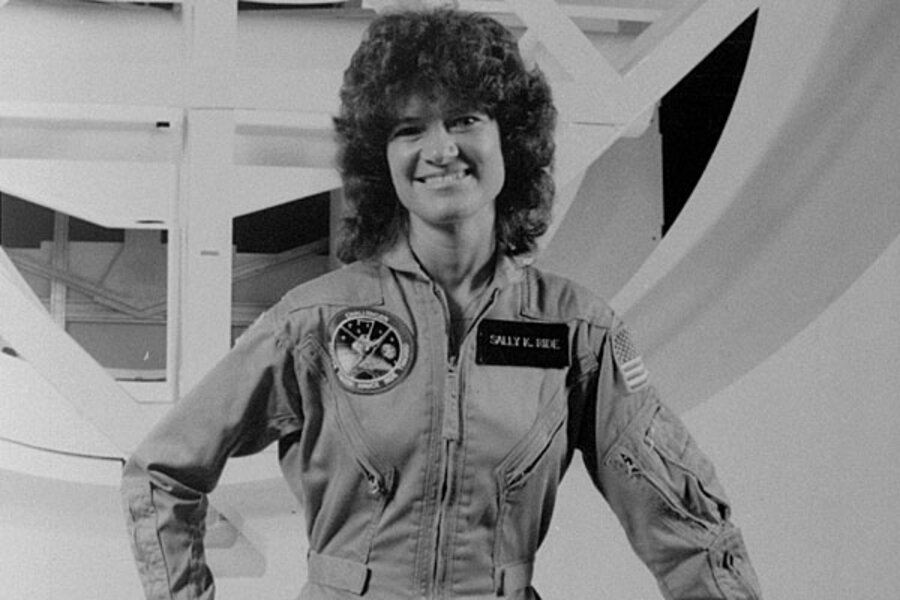Sally Ride: The celebrity-shy, first US woman in space
Loading...
| Cape Canaveral, Fla.
Sally Ride loved everything about space. What she didn't like was being the first American woman to experience it.
It took years — if not decades — for her to get comfortable with her galactic status.
What drew her out was her San Diego-based education company, Sally Ride Science, which promotes science and math careers for girls and young women. She was determined to give back and she did, a thousand times over before her death on Monday at age 61.
The Soviet Union had been lofting female cosmonauts into orbit going back to the flight of Valentina Tereshkova in 1963, who orbited the Earth for almost three days.
RECOMMENDED: Are you scientifically literate? Take the quiz
Ride burst onto the public stage 20 years later when NASA chose her to be the nation's first woman in space.
With her catchy space-flying name and rock-solid science credentials, Ride inspired females the world over with her historic shuttle flight in 1983, five years after she and five other women gained entry to NASA's exclusively male astronaut club.
Some of those girls who looked up to Ride, way back when, went on to become astronauts themselves. Ride, a physicist, proved that women could be equal partners in space and that they, too, could aspire to such heights.
Ride was intensely private, though, and spurned the news media.
Her astronaut ex-husband, Steve Hawley, recalled Monday how she found herself "a very public persona," and "it was a role in which she was never fully comfortable."
"While she never enjoyed being a celebrity, she recognized that it gave her the opportunity to encourage children, particularly young girls, to reach their full potential," Hawley said in a statement.
In all, Ride flew just twice in space, both times aboard Challenger. A third shot at orbit vanished when the Challenger blew up. She found herself investigating the 1986 launch accident and in 2003 was back on a presidential panel looking into Columbia's destruction during its trip back to Earth, the echoes, as she put it, coming in loud and clear.
She lamented the fact that on the 20th anniversary of her record-breaking spaceflight, she was presiding over yet another shuttle tragedy.
Yet she said she'd jump at the chance to fly again on a shuttle, even after such horrific events, provided she could skip all the hard work that went into a mission.
There were times, though, that she wished she hadn't been first. Her female astronaut colleagues back then said they were glad it wasn't them.
The scrutiny, in and outside NASA, was off the scale. Ride was bombarded with sexist questions by reporters before her maiden voyage.
One newsman asked whether Ride wept when things went wrong. Another reporter asked if she planned to have children, and another wondered if she'd wear a bra in space. "There is no sag in zero-g," she replied.
At one point, Ride complained, "It's too bad this society isn't further along and this is still such a big deal."
She refused this reporter's request for an interview on the 10-year anniversary of her flight, but accepted a chance at reminiscing on the 20th.
"It was a huge honor," Ride said in an interview with The Associated Press in 2003. "On the other hand, it sure did complicate things. I'm the sort of person who likes to be able to just walk into the supermarket and not be recognized. I can do that most of the time now."
"A lot of people recognize the name. Very few recognize my face. That's very good," she said, laughing. "That is very good."
Ride was encouraging and highly supportive when astronaut Eileen Collins became the first female shuttle pilot and, consequently, commander back in the 1990s.
Collins was among the young women inspired by Ride's courageous journey and, like so many others, were stunned to learn of her death.
"Sally left us too soon," Collins said in a statement put out by NASA. "God Speed Sally, you will be greatly missed."
RECOMMENDED: Are you scientifically literate? Take the quiz
Copyright 2012 The Associated Press.





